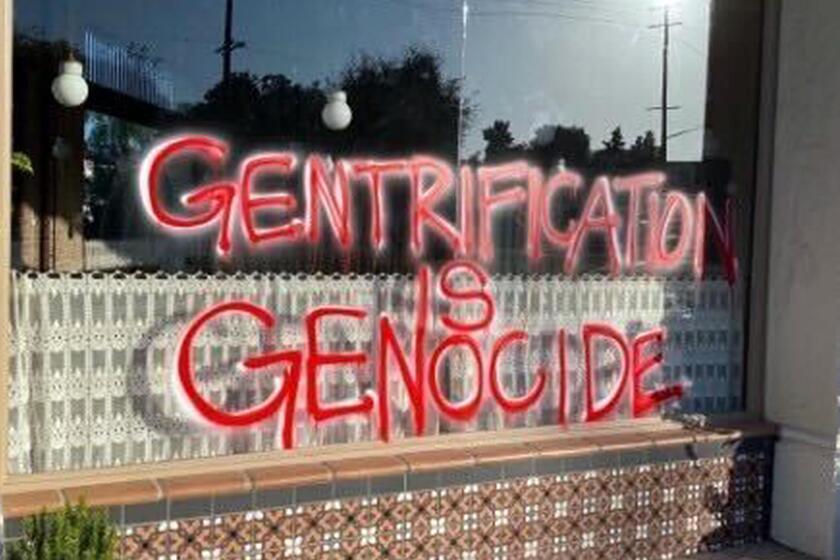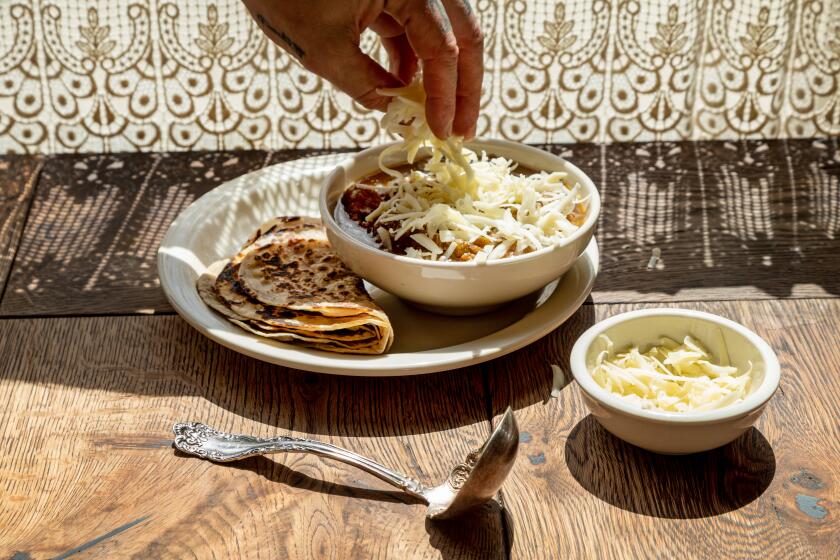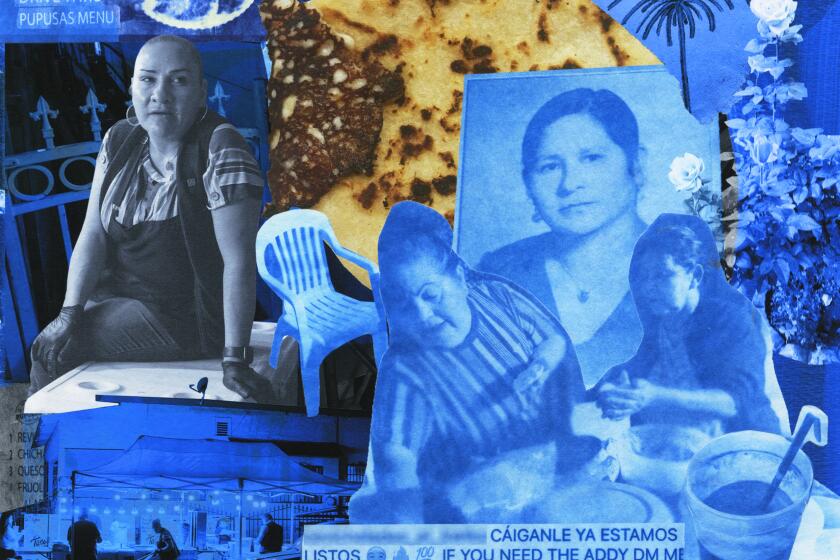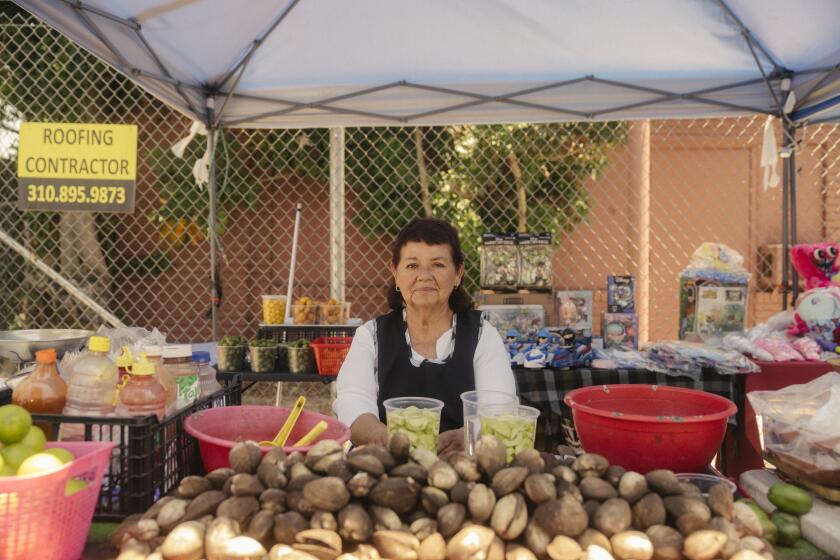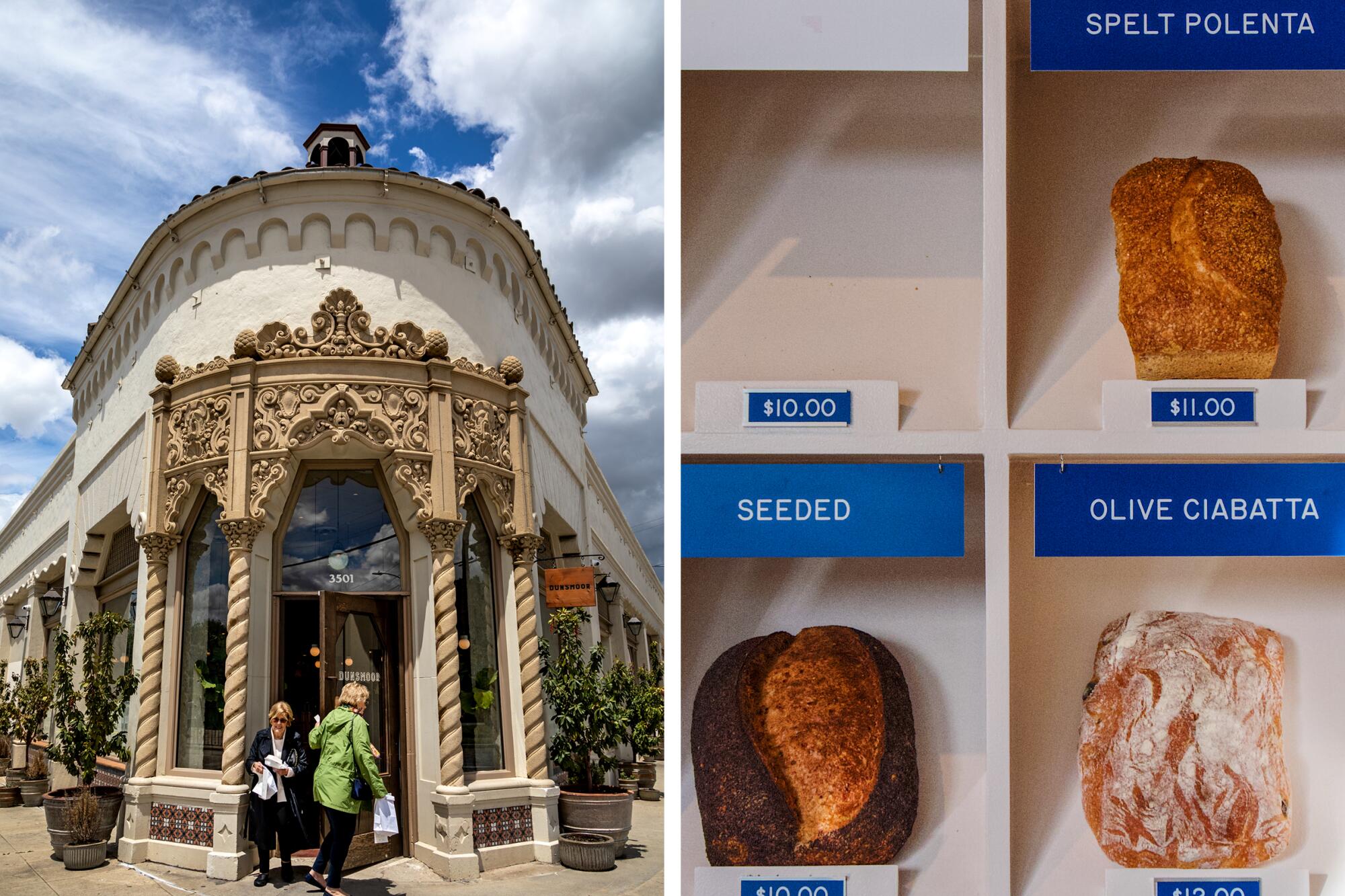
A writer invited longtime neighbors to taste new restaurants Dunsmoor and Bub and Grandma’s. But first let’s talk about parking.
- Share via
In the L.A. food world this past year, there’s been a lot of buzz — cautious buzz — around Dunsmoor.
The restaurant’s identity is built around its “heritage cookery” menu. That is, open-fire hearth cooking and recipes that reflect chef Brian Dunsmoor’s intense interest in pre-20th century U.S. history, including Black and Native American culinary traditions. Dunsmoor is a draw in and of himself, with previous successful restaurants in L.A. and the de rigueur tattoos of a hot-shot chef. His knuckles read “CAST IRON.”
When it opened last year in majority-Latino Glassell Park, it was targeted by a burst of anti-gentrification protests. At the time, many of Dunsmoor’s defenders claimed the restaurant was being unfairly singled out for a process that was already well into motion long before its arrival. The protests, which included non-neighbors, died down, and in time Dunsmoor has become one of the most sought-after seats among the Eastside creative class, with a few celebrity sightings sprinkled in.
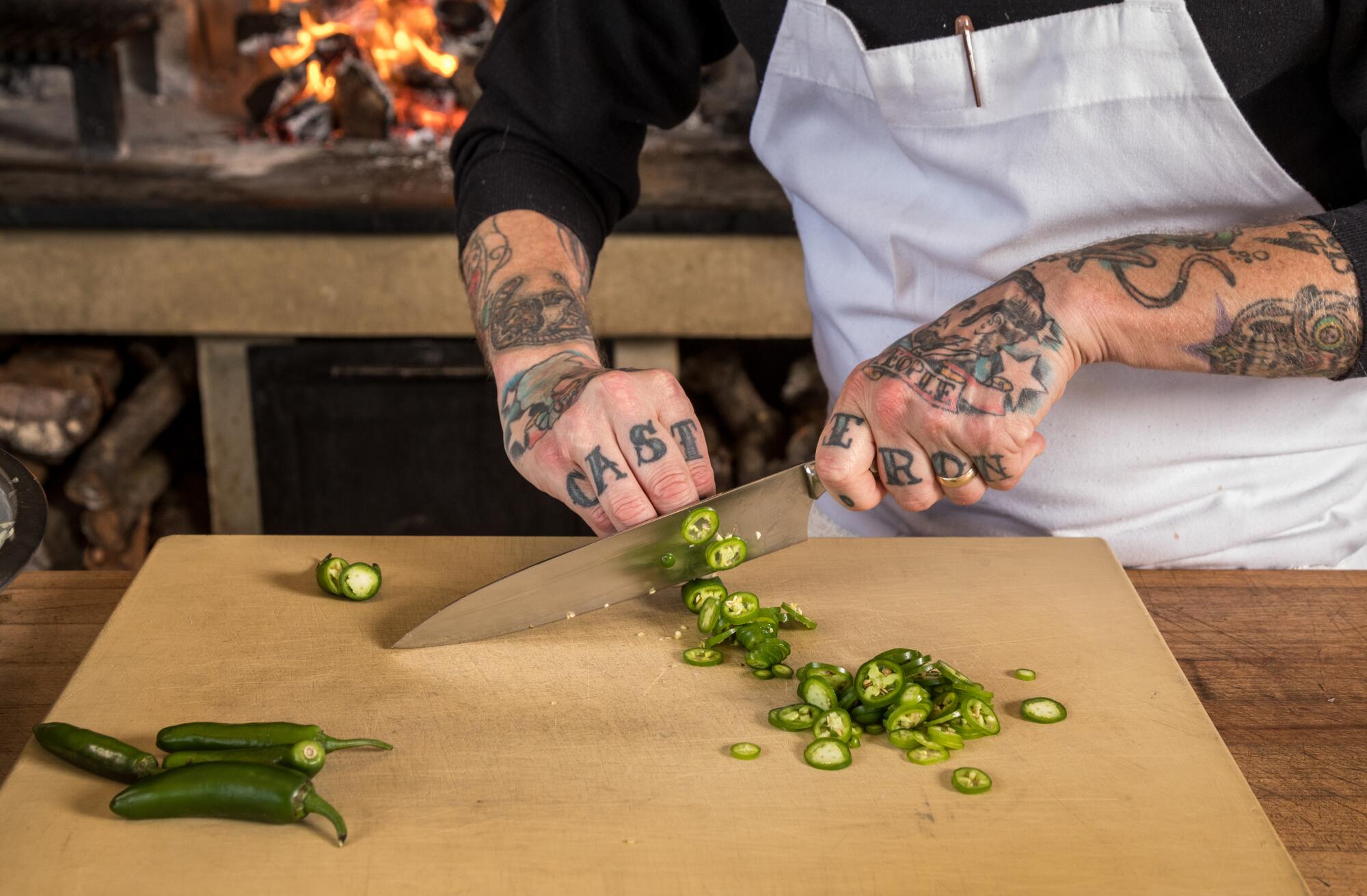
Splashy restaurant and bar openings in traditionally working-class neighborhoods are now commonplace in L.A. But the voices of people and families who built the neighborhoods that newer businesses affect often go unheard.
‘A friend told me they have a lentil dish. I can make it at home and it tastes better.’
On a recent walking tour of this corner of Glassell Park, I struck up conversations with residents I encountered, keeping a couple of questions in mind: Did they think these new businesses served the area? How have neighbors been affected? I also convinced a few local residents to sample and give an honest assessment of the food at Dunsmoor and the bakery-turned-sandwich shop next-door, another hit called Bub and Grandma’s.
I ended up chatting with about 10 neighbors about the new openings — not exhaustive, but enough to get a range of opinions that depended on variables including whether they rented or owned and how long they’d been in the neighborhood.
One complaint was more or less universal: Parking has become terrible.
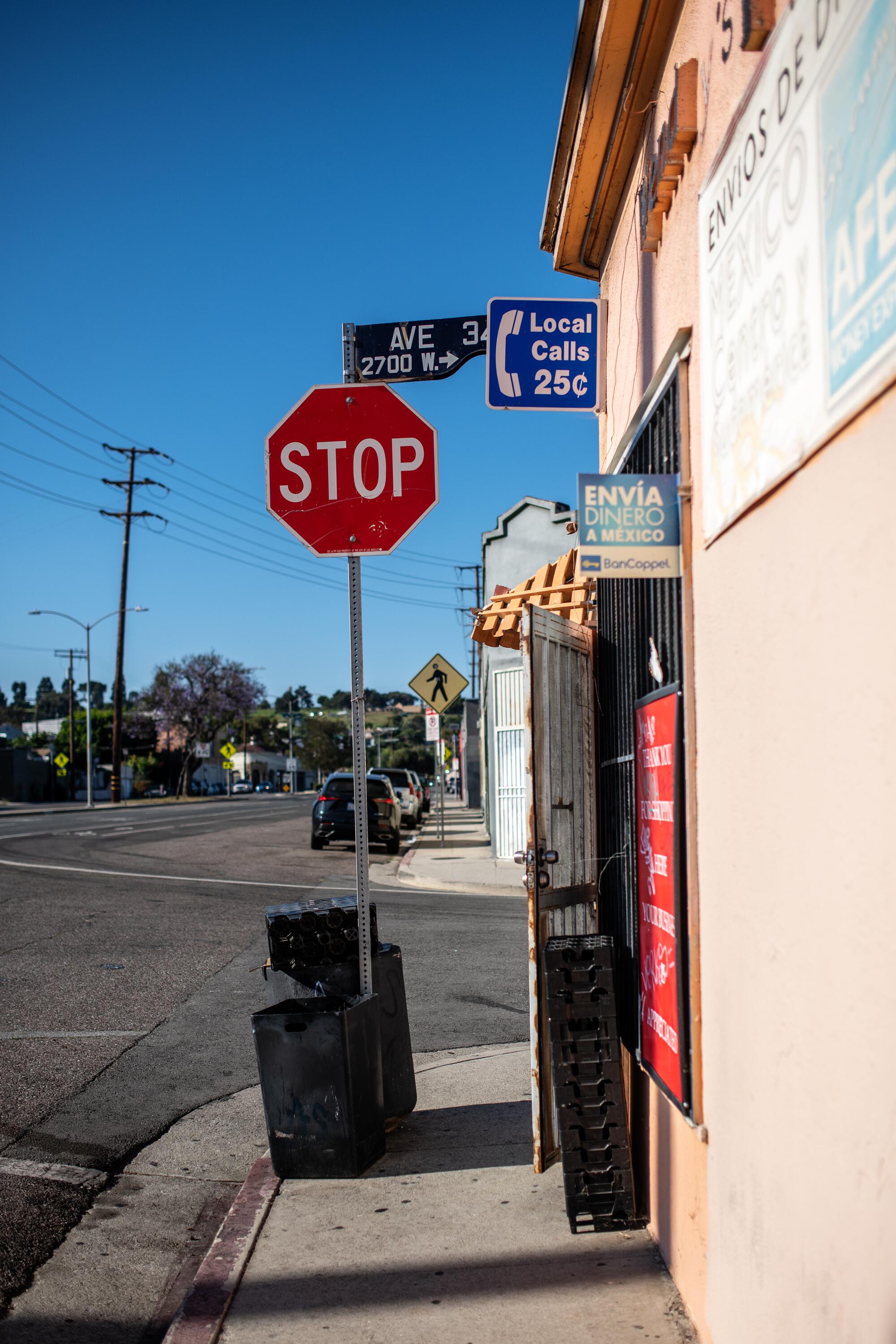
Rosie, among the people I spoke to who declined to give their last names, has lived in the neighborhood since 1973 and remembers when the building housed a bank and a car upholstery business. She said parking and traffic have become untenable and hopes her street is made permit-only.
“I wish their customers would be more considerate,” she said of Dunsmoor, which, for the record, has a valet.
But she’s happy there’s a business in the space. “I’d rather have this than an empty building,” Rosie said.
Down the block, a man who gave his name as Jose and said he purchased his home in 1985, also complained about limited parking, blocked driveways and cars that take up two spots (something he referred to as “double parking”). He complained that customers don’t observe the parking time limits on the painted curb in front of his house, where he runs a daycare facility.
Jose said he had no interest in patronizing any of the new businesses on that block. “It’s not for me,” he said.
Dunsmoor, an upscale new restaurant in L.A.’s Glassell Park neighborhood, was hit with protests and “Gentrification Is Genocide” graffiti on opening night.
Dunsmoor did not respond to multiple emails requesting comment for this story.
Jose’s son, Brian, was slightly more sanguine in his assessment. “Any change, there’s going to be pros and cons,” said Brian, who was the first person in his family to graduate from college. “Broadly speaking, I feel like the neighborhood has gotten safer.”
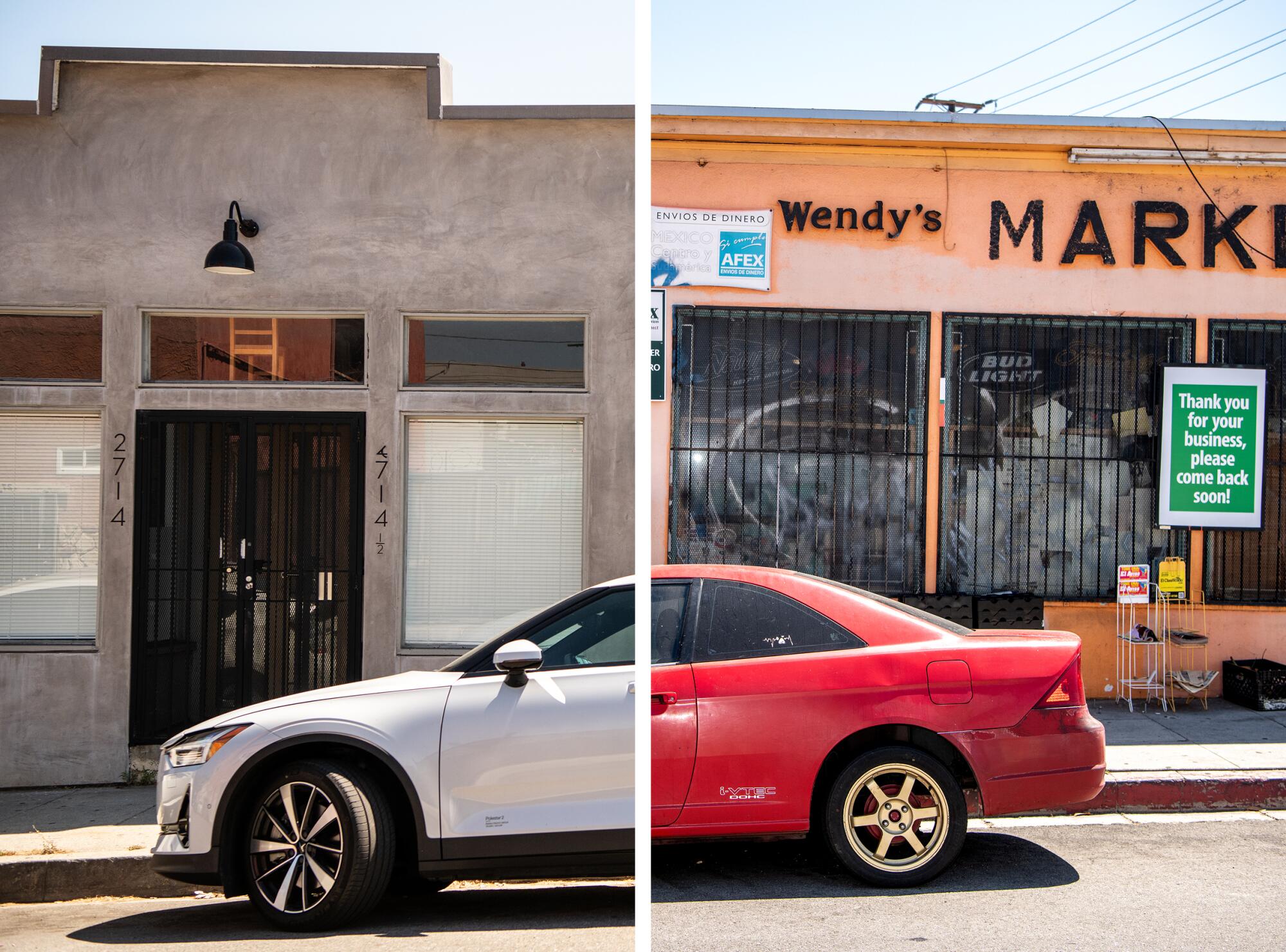
But with an influx of newcomers, and new money, comes a sense of entitlement, Brian said. “People are coming here ... and not treating it like a residential area,” he said.
Did he feel that the new businesses were there to cater to the immediate neighborhood?
“It doesn’t feel like that,” Brian said.
‘I understand the controversy with gentrification, but if the alternative is an empty building?’
On the same street, Eloisa, a resident of 23 years, also said she had no interest. “I heard it’s expensive,” she said of Dunsmoor. “A friend told me they have a lentil dish. I can make it at home and it tastes better.”
But Sean Dore said that recent changes had been “positive for the neighborhood,” noting that there weren’t protests when other businesses, like nearby Wife and the Somm, opened. “I understand the controversy with gentrification, but if the alternative is an empty building?” he asked.
Another resident, Ana Maciel, noted that the neighborhood has morphed in the few years she’s been there: “It’s changed who you see in the neighborhood,” she said.
The journey of a humble bowl of stew, from rural Colorado to urban California, and how it became a beloved restaurant dish on the menu at Dunsmoor.
“This store up here is an organic blah blah blah, so there’s a lot of people I wouldn’t usually see in the neighborhood taking up all the parking,” she added, referring to LA Homefarm, a new produce and home goods market on Eagle Rock Boulevard.
Maciel, a renter, recently had to move when her monthly rent jumped by $1,800. She said that new, expensive businesses affect people like her differently than homeowners. “I’m sure the people that own homes, it’s great for them. But not for people who rent,” she said.
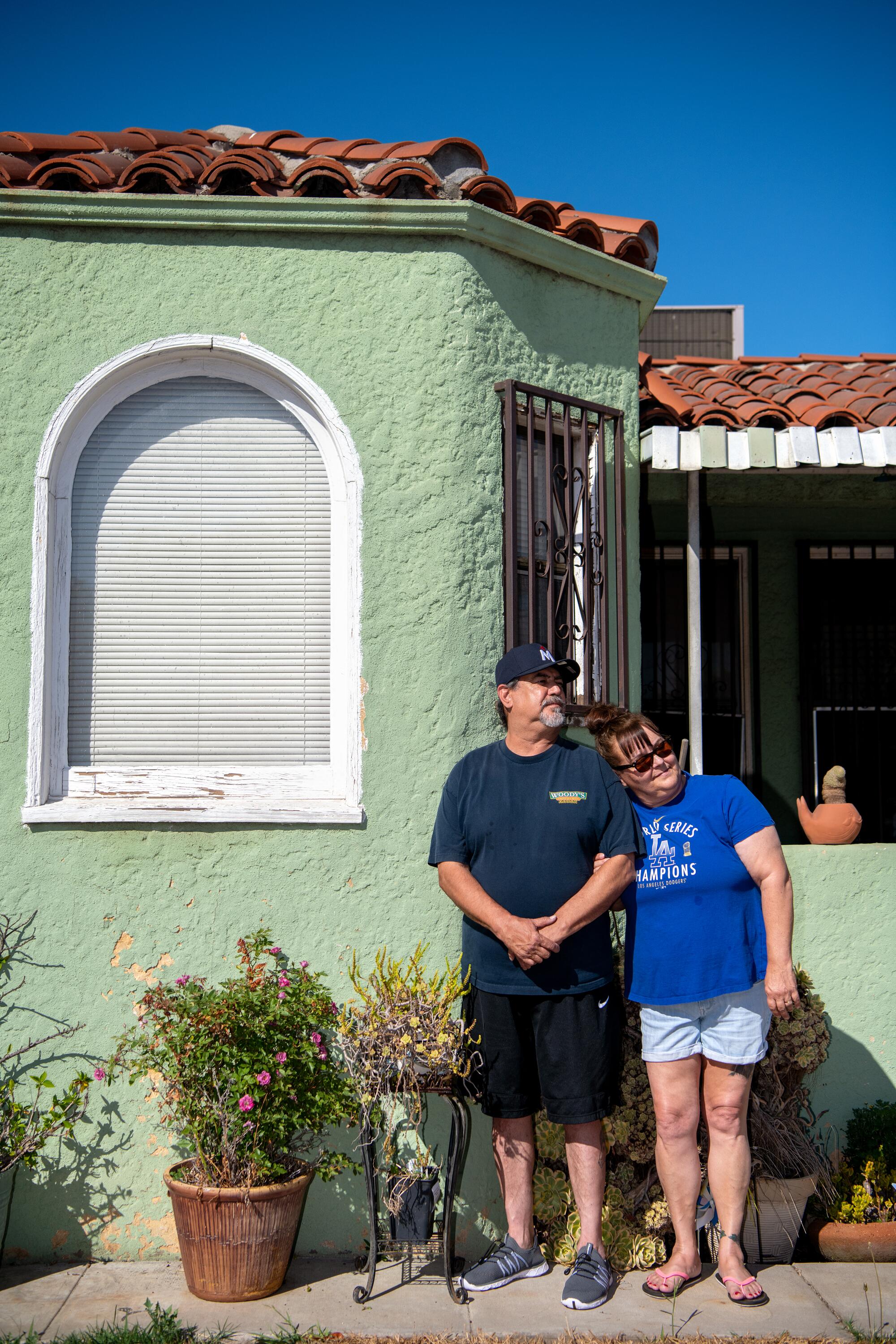
Meet the Samaniegos
I hadn’t eaten at Dunsmoor since it opened and was curious to make another trip. But I was more interested in how its immediate neighbors felt about it: Did they even eat there? As diners enjoyed their pork chops and chopped chicken liver, would longtime Glassell residents have another perspective? So I went again. But this time, I invited a couple from down the street to try it with me.
My dining companions, Fernando and Sherry Samaniego, had never been to Dunsmoor. They’d lived just a couple blocks away for over 30 years in a house that once belonged to Sherry’s grandparents and that, like the building where Dunsmoor is housed, was built around the time of the Great Depression.
The Samaniegos are homeowners. “I don’t mind them,” Sherry said of the new businesses when I first met her. “It just sucks for parking.”
When I asked if she thought the businesses were here to serve the neighborhood, she smiled and said, “I think they’re here for themselves.”
‘I’d come back if they put some rice with that chile verde.’
But Sherry and Fernando were interested in meeting me for a meal at Dunsmoor. On our short walk over, I got to learn a bit about them.
They’d raised three kids and had two grandchildren and were expecting a third. Sherry worked as a gardener for the city — she serviced parks in the area like Debs, Glassell and Eagle Rock — but suffered a back injury and was forced to stop working. Fernando, a big, gregarious guy with a goatee, had worked as a tile setter since he was 12. He learned the trade from his grandfather, who was from Mexico (Fernando couldn’t remember exactly where) and began tiling after serving in the Army in World War II.
On a clear and balmy evening, we walked through Dunsmoor’s ornate doorway and were seated at a table near the kitchen and its big, open fire. The glassware was polished, the place settings perfect. Bottles with what looked like yellow chrysanthemums were laid out on two- and four-tops.
After we had looked at the menu, I asked Fernando and Sherry what their initial impressions were. Fernando raised his right hand high in the air, as if to indicate a very tall person. High prices, he said.
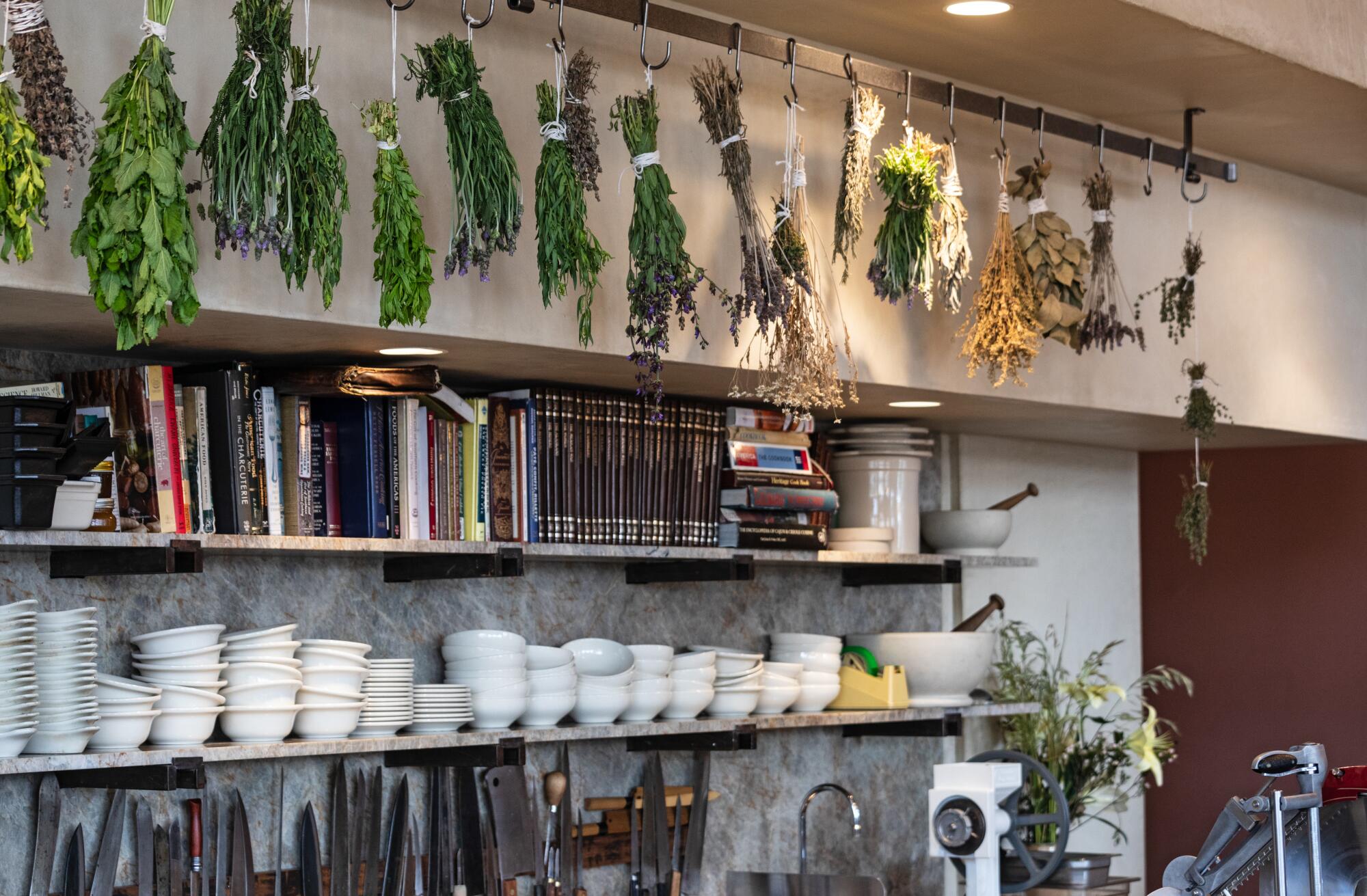
Sherry furrowed her nose slightly and said, “There’s not really too much stuff here that I like.” Fernando was feeling more adventurous, but even he had places he wasn’t willing to go. “Chopped chicken liver is where I draw the line,” he said.
But skepticism wore away as we talked more and our evening progressed. We put our order in: bison tartare, country ham, Caesar salad, cornbread, pork and green chili stew and the beef rib-eye.
“That’s a lot of food,” our server said, eyebrow raised. There would be leftovers.
Sherry said she didn’t like slick or slimy textures and opted out of the tartare; Fernando tried it and said it reminded him of sushi with a salsa accompaniment. Sherry liked the cornbread, soaked in butter and honey, which used to appear as “sour milk cornbread” on the menu and now is called “Edna’s sour milk cornbread” after chef Edna Lewis. Both enjoyed the chicory Caesar — Fernando said he’d never eaten a Caesar salad in a restaurant before.
Visit an award-winning taco shop to explore the best food, art and music in L.A.’s Highland Park neighborhood. Watch video, browse articles and more.
We ate and talked: About our families, L.A. sports, Sherry and Fernando’s courtship and how they took over the house where they now live after Sherry’s grandmother fell ill with Alzheimer’s. Sherry began working as a gardener with the city in 2000 — mowing, edging, repairing sprinklers, dealing with trash — anything to do with park maintenance.
“There were a lot of gangs, a lot of gunshots,” she said of how the neighborhood used to be. Both said that the recent changes in the area, including Dunsmoor’s opening, were for the better.
“I feel safer walking because of all the people,” she said.
I asked them if, looking around the dining room, they thought the diners were local or from other parts of town. “I don’t think anyone here today is from the neighborhood,” Fernando said.
Why not call it chile verde?
The pork and green chili stew was the favorite — even though Fernando, a self-described “corn tortilla guy,” initially didn’t like that it came with flour tortillas and said he wished he had some Spanish rice to eat with it.
They both began referring to the dish as “chile verde,” a staple of Angeleno Mexican kitchens going back to the migration patterns from Texas, Chihuahua and in between.
The steak, both agreed, was fairly unimpeachable, and at its then-$89 price Fernando considered it a decent deal considering how much meat you got. (The rib-eye has since risen to $99.)
Both agreed: They would come back.
“Well,” Fernando paused. “I’d come back if they put some rice with that chile verde.”
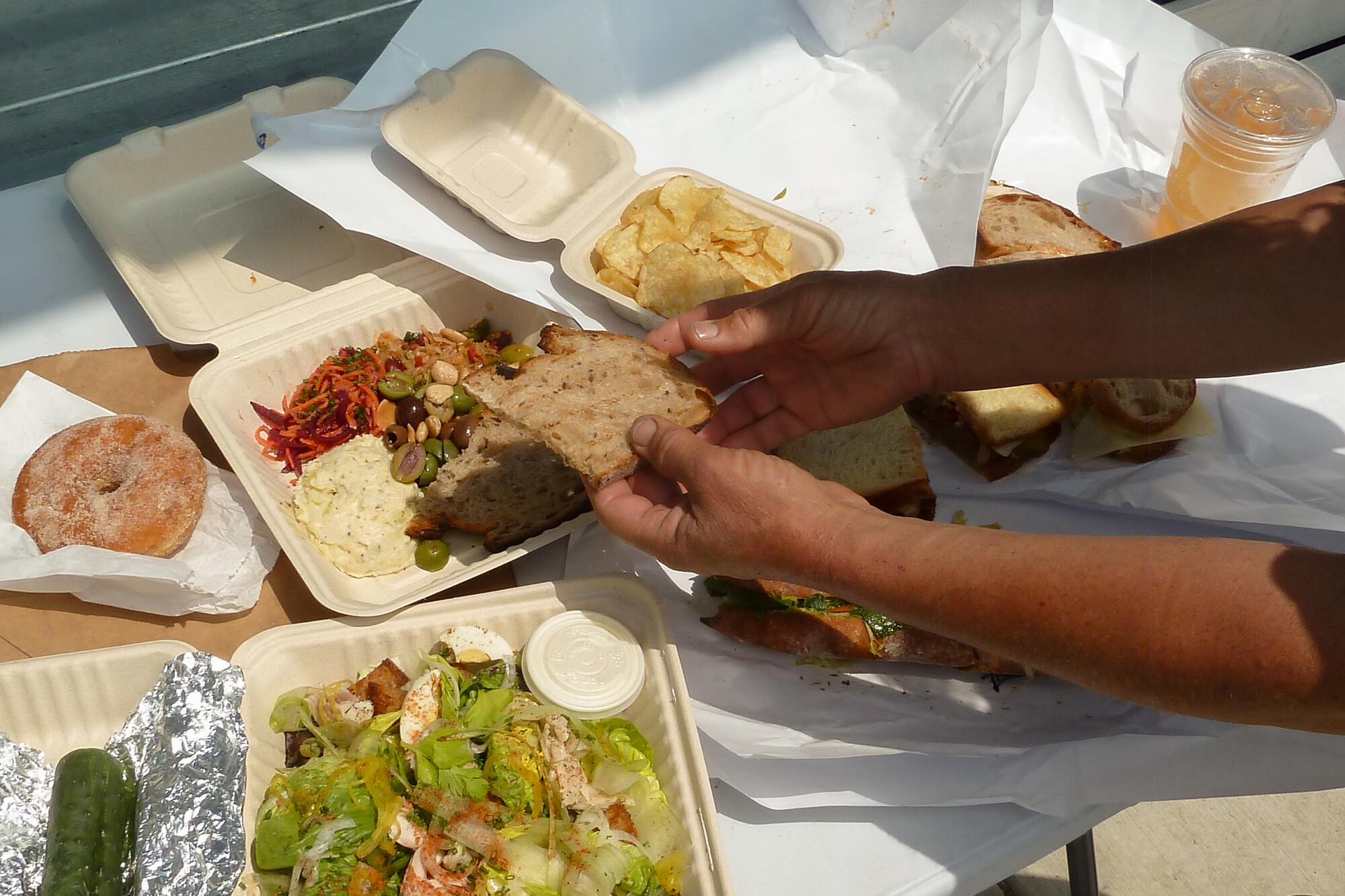
Sandwiches with an unhoused neighbor
On a tip from a different neighbor, I located a Glassell Park resident who goes by Emptea, who has lived unhoused for the last nine years. Emptea, who uses they/them pronouns, had stayed in front of the building that Dunsmoor now occupies and was a participant in the anti-gentrification protests last year.
Once employed in the catering and the restaurant industry, Emptea had strong opinions about the new business openings and their effect on the community.
Emptea, who has two (very sweet) dogs by their side at nearly all times, was careful not to say they were displaced by Dunsmoor, specifically. “When you live houselessly, you need to be ready to be on a move at a moment’s notice,” they said — but agrees they could have stayed put longer had Dunsmoor not opened when it did.

Emptea grew up in Indianapolis and moved to L.A. around 1995. They said they were greatly influenced by the Occupy Wall Street movement in 2011 and are now active in the Glassell Park community, attending local tenants’ meetings and hosting weekly food distributions.
“The interests of places like Dunsmoor and other high-priced gentrifiers or gentrifiers of all kinds, including Bub and Grandma’s, and the interests of the working class and poor, particularly non-white people, are irreconcilable,” Emptea said.
“They can use all the woke … language they want to: They want to support people or they want to support the community or they care about community needs and so forth. They don’t,” Emptea said. “They care about being able to pay their lease and make good on their commitment to their investors.”
Emptea loves to cook and regularly makes food for the community with their outdoor setup: potato salad, lentils, brussels sprouts. Food and joy, they said, should cost nothing — a distinctly anti-capitalist and possibly unrealistic notion when Emptea puts it in their perspective.
“Bread has been baked for 5,000 years and most of that 5,000 years no one paid a dime for it. Now was it as good as [Bub and Grandma’s owner] Andy Kadin’s bread? We can argue whether it was or not. However, we do not need to pay for bread.”
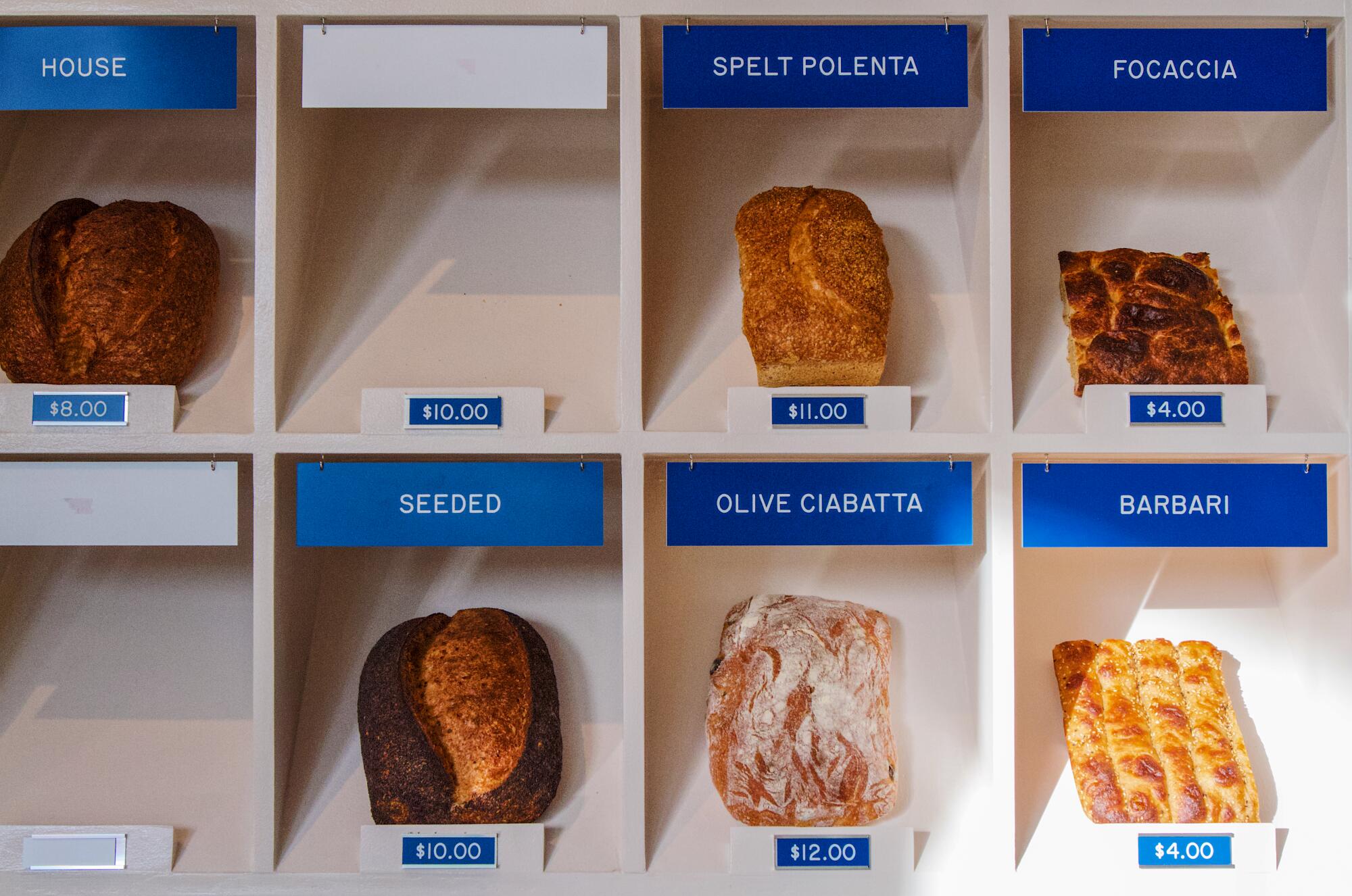
I spoke to Kadin and he disagreed with the notion that his business and the well-being of the neighborhood are fundamentally at odds, calling it “absolutist and not based on interactions with the people who are claimed to be doing the gentrifying.”
“I am empathetic to the anti-gentrification movement and that’s a tricky position to be in as a restaurant owner,” said Kadin, who developed a distaste for “corporate b—,” as he called it, after working for years in advertising.
Kadin said he’s “very conscious” of the neighborhood and is mindful of keeping prices affordable as well as taking care of his staff, providing healthcare benefits and cellphone stipends. Bub and Grandma’s gives locals a 5% discount and provides a parking map on its website that requests that diners not disturb neighbors.
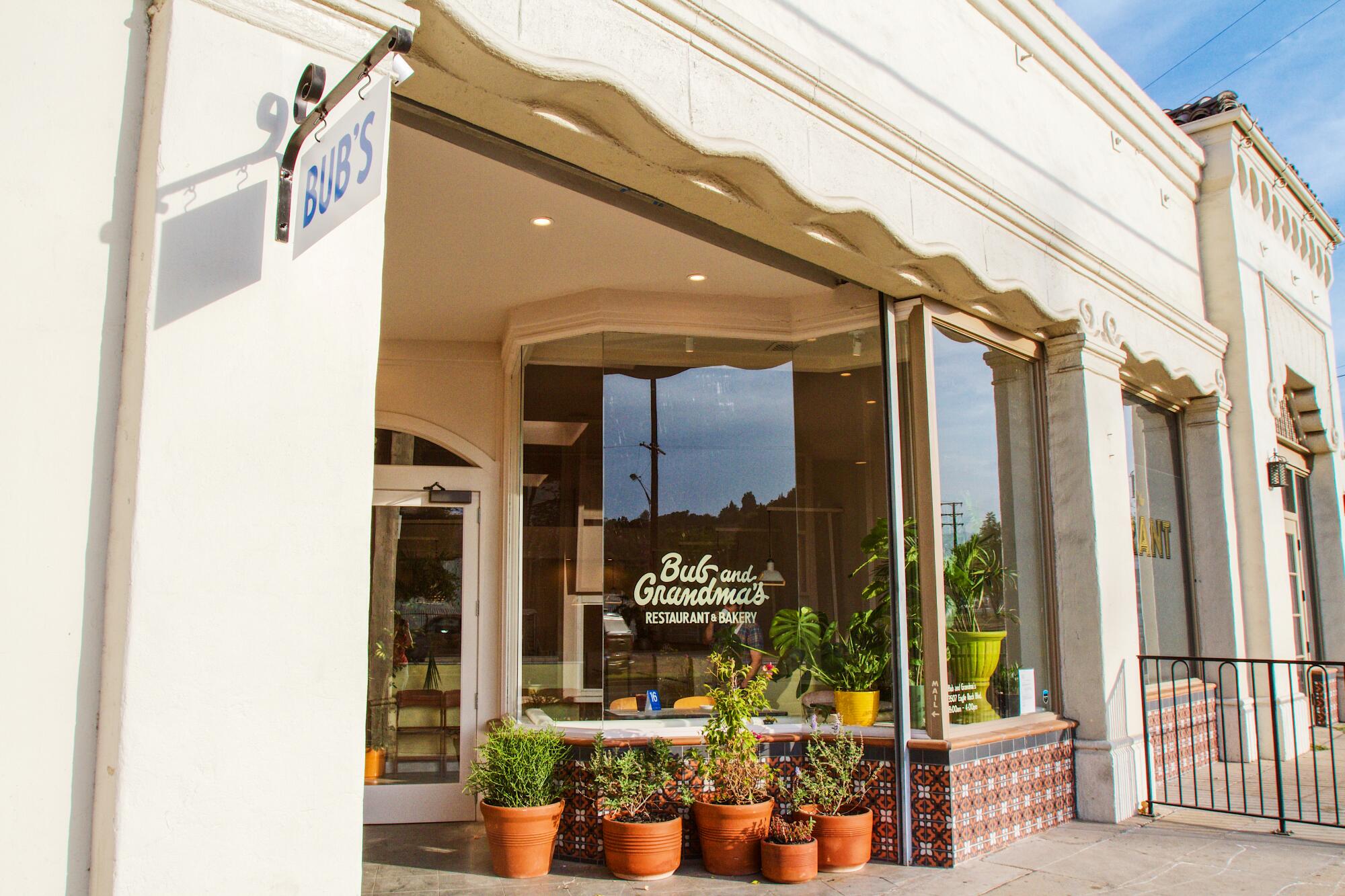
He said that in the 13 years he’s lived in the neighborhood, he’s seen corporate development that’s been detrimental to the community. “But to lump any new business together under that umbrella isn’t necessarily a productive approach,” he said.
Emptea, with a culinary background, was curious about the food from Bub and Grandma’s and receptive when I suggested bringing a few items to where they were staying. We agreed to have lunch from there.
One Monday afternoon, I showed up with a smoked trout salad, veggie and turkey sandwiches, a sampler of side dishes and a few other items. The person who took my order at the restaurant gave me a small, metal token good for a locals’ discount, which I gave to Emptea. We snacked and chatted while the dogs looked on, very interested.
DM for addy and unlock a world of dining that edges into the sublime.
Emptea was torn, I could tell, between enjoying the food and regretting the decision to dine with me. The verdict after tasting almost everything? Positive.
The veggie sandwich and side sampler were favorites. “It’s delicious,” they said. “You know like when a singer goes flat … or a skater falls and they get back up? There’s none of that here.”
But simply tasting good, they maintained, did not erase any of their overarching concerns. “Is this delicious? That is not the question we need to be asking. It’s: What are the consequences to my brothers and sisters, my family members?”

A shifting neighborhood
Jose Garcia runs Wendy’s Market, a convenience store a block from popular Verdugo Bar and a few blocks from Dunsmoor. He also used to operate a market called El Mexicano across the street — where LA Homefarm, which sells Andy’s Orchard produce, Wild Terra herbs and upscale home goods, opened last year.
Garcia said he feels the neighborhood is actually less safe now than it used to be. Not only that, but business was significantly better for him in the ’90s and ’00s. “In the ’90s and 2000s there was good, good business,” Garcia said.
He picked up a small package of pan dulce sitting near the cash register. The non-Latinos in the area, he said, weren’t going to buy this type of thing. “[They] look at the company, they look at the calories,” he said.
The longtime market on Vermont Avenue has returned after a difficult year, but can its vendors find a way to survive?
Garcia, who came to the U.S. from Zacatecas, Mexico, when he was 6 years old, opened his first convenience store in East L.A. in the 1970s. He said he opened El Mexicano in the early ’90s but eventually closed the business to use as a storage space, where it remained dormant for many years. Garcia said he vacated the space a few years ago but had hoped he could eventually reopen El Mexicano. Instead, the building was sold and LA Homefarm came in as tenants.
Lauri Kranz and Dean Kuipers (a former Times editor) opened LA Homefarm last year. Kranz said they’ve received positive feedback from neighbors who are happy there’s an active business in the space again. “Both Dean and I are very sensitive to what’s happening and that the neighborhood has shifted and is shifting,” Kranz said.
Kranz said they donate unsold perishables to a communal refrigerator across the street and make a conscious effort to keep their produce affordable.
“We both just want to be able to help provide for community,” she said. “We try to do that by offering the neighborhood discounts, by trying to keep all the produce prices as low as we can.”
It was a short list that ignored a swath of cuisines and neighborhoods. No tacos, Chinese, Thai, Ethiopian, Vietnamese, Japanese or anything beyond sandwiches and fried chicken.
Now 75 years old, Garcia said he plans to retire soon. Landlords in the area, he said, don’t want tenants like him anymore. “I feel like they’re going to make it [non-Latino] businesses,” he said. “I feel it, I see it.”
How did that make him feel? I asked.
“I feel bad,” he said.
More to Read
Eat your way across L.A.
Get our weekly Tasting Notes newsletter for reviews, news and more.
You may occasionally receive promotional content from the Los Angeles Times.
